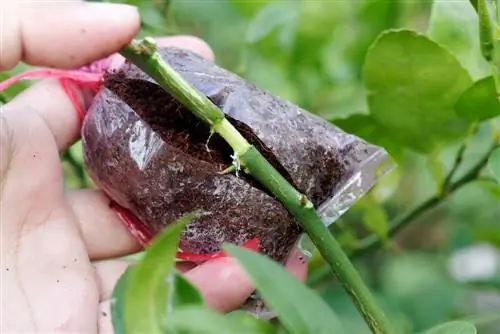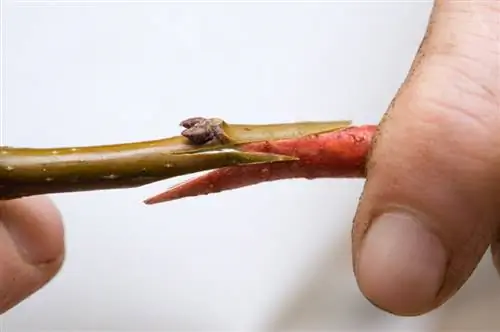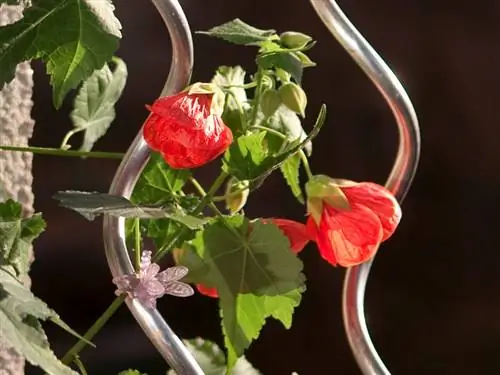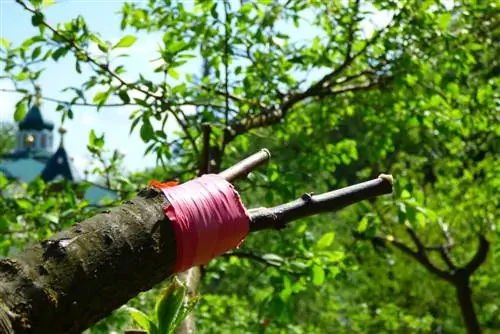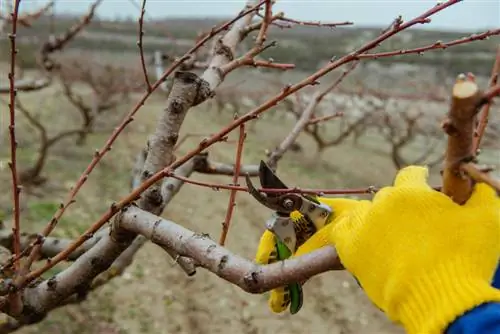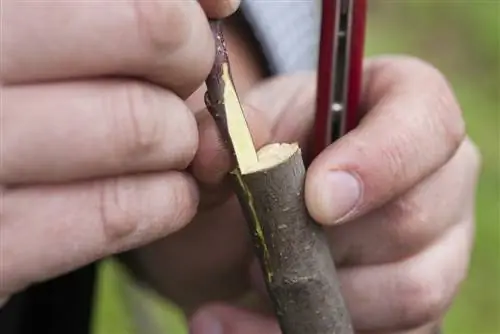- Author admin [email protected].
- Public 2023-12-16 16:46.
- Last modified 2025-06-01 06:02.
Although fruit trees can also be propagated through cuttings, cuttings or seeds, grafting is the quickest way to produce a fruit-bearing tree. This process can also be used to transfer certain properties (such as growth strength and height, required soil properties). Refining is not a difficult technique to learn; it was successfully used by our ancestors thousands of years ago.
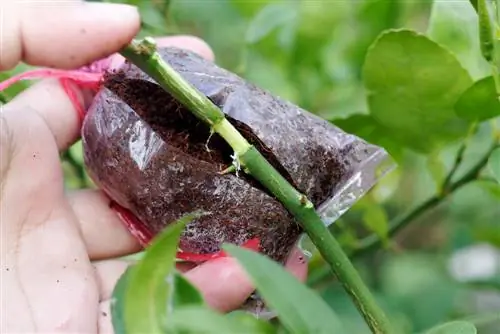
How does grafting fruit trees work?
Grafting fruit trees is a method in which scions (young shoots of the desired variety) are grafted onto a rootstock (rootstock of another fruit species/variety). This accelerates growth, enables pure cultivation and influences growth behavior. Grafting processes include copulating (winter) or seeding (summer).
What is “refining”?
Refining plants is a form of vegetative propagation in which two (or more) different varieties or compatible species are put together. A scion - i.e. H. young shoots of the desired type of fruit - grafted onto a rootstock. This is the rootstock of a different type or variety of fruit, but one that has the desired properties. Grafting is primarily used to promote faster growth of fruit trees, but also to ensure pure varietal cultivation. The latter would not be possible otherwise with many varieties.
The best time for refining
Basically, refining is possible at any time of the year. You just have to choose the right technology. During the dormant period of vegetation in winter, you can carry out what is known as scion grafting. On the rootstock, the rootstock, you place parts of shoots - these are the shoots of the noble variety - through copulation. If grafting is carried out in summer, only one eye - that is, a bud freed from the leaf and petiole - is inserted into the previously opened bark of the rootstock. The process is called inoculation and is particularly popular when refining fruit trees and roses.
This is what you need to refine fruit trees
In addition to one or more scions (you can also graft several types of fruit onto one base) and a base, you will also need the following tools and materials:
- secateurs (not anvil shears!)
- depending on a copulating or an occlusal knife
- Raffia or a finishing ribbon made of rubber or plastic
- Tree wax
Scion
Cut scions from the fruit tree whose variety you want to grow. You can purchase such a tree in a tree nursery or cut it yourself. Annual shoots that are about as strong as a pencil and have not yet branched are best suited for this purpose. So-called water shoots are also suitable, although the buds should not be too far apart. The latter often indicates that the shoots grew in a poorly exposed area of the tree. The scions cut during winter dormancy can either be refined immediately or initially stored in a cool, moist place so that they do not grow and are available at the desired date. Scions for summer grafting through inoculation, on the other hand, are cut shortly before the date and the leaves are removed with scissors or a knife.
Documents
The term “rootstocks” refers to the rootstocks on which the noble varieties are planted. These rootstocks ultimately determine the growth behavior and, depending on the variety, can be used for certain soils. Saplings that sprout from the ground next to the fruit tree can be dug up in winter and used as rootstock. However, they later also form runners, which are actually not desirable. Varieties of the same species can be grafted onto self-grown seedlings. They are generally vigorous.
The best methods for finishing - including instructions
In addition to the two processes presented here, there are other methods by which refinement can be carried out. These include, for example, flattening, gap grafting, goat's foot grafting, grafting behind the bark and chipping. However, if you have little or no experience with refining, copulation or oculation is best suited - these refining processes are considered particularly simple.
Copulate
The best season for copulation is winter. And this is how it works:
- The bare-root base is cut about ten centimeters above the root neck with a diagonal cut about three centimeters long.
- The cut should be made opposite an outward-facing bud.
- The scion of the same strength is also cut opposite a bud with a cut of the same length.
- Then the scion is shortened to about three buds.
- Now place the cut surfaces together precisely.
- The finishing area is then tightly wrapped with a suitable ribbon.
- Now the entire area is coated with tree wax.
- This is intended to prevent harmful organisms from entering.
It is best to plant the finished graft in a planter with a volume of approx. three to five liters so that the plant can grow and sprout.
Occulate
When inoculating, first cut a pocket into the bark of the base, into which the cut out eye of the scion is then inserted. This process is carried out in the summer - primarily between July and August - whereby the grafting base can remain in the garden soil - you are, so to speak, just grafting a new variety onto an existing trunk.
Tip
If you are unsure about refining, you can attend a corresponding course and learn the various techniques there. Grafting courses are offered by tree nurseries, especially in the winter months.

